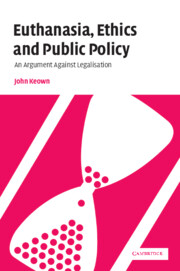Book contents
- Frontmatter
- Contents
- Preface
- Foreword
- Acknowledgments
- Table of cases
- List of abbreviations
- Introduction
- PART I Definitions
- PART II The ethical debate: human life, autonomy, legal hypocrisy, and the slippery slope
- PART III The Dutch experience: controlling VAE? condoning NVAE?
- 8 The guidelines
- 9 The first Survey: the incidence of ‘euthanasia’
- 10 Breach of the guidelines
- 11 The slide towards NVAE
- 12 The second Survey
- 13 The Dutch in denial?
- PART IV Australia and the United States
- PART V Expert opinion
- PART VI Passive euthanasia: withholding/withdrawing treatment and tube-feeding with intent to kill
- Conclusions
- Afterword
- Bibliography
- Index
10 - Breach of the guidelines
Published online by Cambridge University Press: 20 July 2009
- Frontmatter
- Contents
- Preface
- Foreword
- Acknowledgments
- Table of cases
- List of abbreviations
- Introduction
- PART I Definitions
- PART II The ethical debate: human life, autonomy, legal hypocrisy, and the slippery slope
- PART III The Dutch experience: controlling VAE? condoning NVAE?
- 8 The guidelines
- 9 The first Survey: the incidence of ‘euthanasia’
- 10 Breach of the guidelines
- 11 The slide towards NVAE
- 12 The second Survey
- 13 The Dutch in denial?
- PART IV Australia and the United States
- PART V Expert opinion
- PART VI Passive euthanasia: withholding/withdrawing treatment and tube-feeding with intent to kill
- Conclusions
- Afterword
- Bibliography
- Index
Summary
In how many cases of VAE was there a ‘free and voluntary’ request which was ‘well-considered, durable and persistent’? In how many was there ‘intolerable’ suffering for which VAE was a ‘last resort’? In how many did the doctor consult with another doctor and subsequently report to the authorities? The Survey contained telling evidence also about the extent to which Dutch doctors did, and did not, comply with the guidelines. This chapter will summarise that evidence, which betrays widespread non-compliance with the guidelines, not least the practice of NVAE.
An explicit request
An ‘entirely free and voluntary’ request which was ‘well considered, durable and persistent’?
Doctors stated that in the 2,700 cases of VAE and PAS there was an ‘explicit request’ in 96%; which was ‘wholly made by the patient’ in 99% of cases and ‘repeated’ in 94%; and that in 100% of cases the patient had a ‘good insight’ into his disease and its prognosis. Oddly, no specific question was put about the voluntariness of the request and there is no evidence of any mechanism which could have guaranteed that the request was voluntary. Moreover, the request was purely oral in 60% of cases and, when made to a GP in cases where a nurse was caring for the patient, the GP more often than not failed to consult her. There is no way of gauging the accuracy of the doctors' statements, which were uncorroborated, about the patients' requests.
- Type
- Chapter
- Information
- Euthanasia, Ethics and Public PolicyAn Argument Against Legalisation, pp. 103 - 114Publisher: Cambridge University PressPrint publication year: 2002

